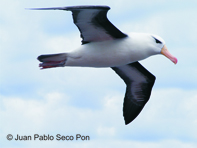Juliana Coffey (Torngat Wildlife, Plants, and Fisheries Secretariat, Goose Bay, NL, Canada) writes in the Northeastern Naturalist of an equator-crossing Black-browed Albatross Thalassarche melanophris which was observed from a longline fishing vessel.
The paper's abstract follows:
"Thalassarche melanophrys (Black-browed Albatross) has rarely been sighted in the northwest Atlantic, with fewer than 30 anecdotal and fewer than 10 confirmed sightings spanning the West Indies north to Greenland. On 8 August 2009, a Black-browed Albatross was observed from a longliner conducting an exploratory Chionoecetes opilio (Snow Crab) survey, off the coast of northern Labrador. This sighting currently represents the most northerly record for continental North America. The only more northerly records are two specimens seen off Greenland. Black-browed Albatrosses have been seen more frequently, though rarely, in the eastern North Atlantic, while they have yet to be documented in the north Pacific. Given the higher frequency of sightings along the European coast, it may be that the majority of Black-browed Albatrosses crossing the equator are traveling up the African coast. Black-browed sightings on the Atlantic coast of North America therefore may originate in northern Europe, or from birds traveling along the Atlantic coast of South America."

Reference:
Coffey, J. 2012. Black-Browed Albatross (Thalassarche melanophrys) sighting off northern Labrador, Canada. Northeastern Naturalist 19: 130-134.
John Cooper, ACAP Information Officer, 15 May 2012

 English
English  Français
Français  Español
Español